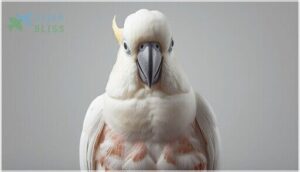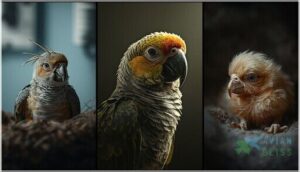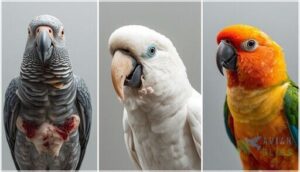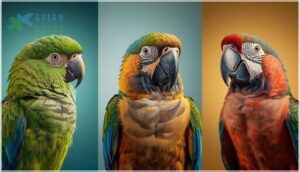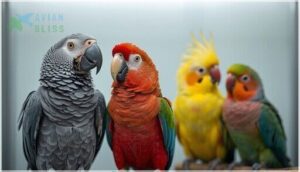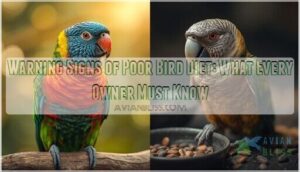This site is supported by our readers. We may earn a commission, at no cost to you, if you purchase through links.
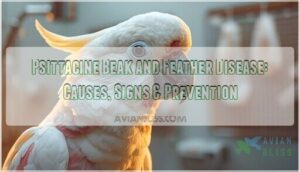
Psittacine beak and feather disease doesn’t announce itself with fanfare—it creeps through aviaries and living rooms alike, transmitted through something as innocent as shared feather dust. This circovirus has spread across continents through the pet trade, now affecting parrot populations from Australia to Africa with prevalence rates that climb as high as 70% in some regions.
Understanding how this resilient pathogen operates, which species face the greatest risk, and what clinical signs demand immediate veterinary attention can mean the difference between early intervention and irreversible damage to your bird’s health.
Table Of Contents
- Key Takeaways
- Causes of Psittacine Beak and Feather Disease
- Clinical Signs of Psittacine Beak and Feather Disease
- Diagnosis of Psittacine Beak and Feather Disease
- Forms of Psittacine Beak and Feather Disease
- Management and Prevention of Psittacine Beak and Feather Disease
- Vulnerable Species to Psittacine Beak and Feather Disease
- History and Spread of Psittacine Beak and Feather Disease
- Avicultural Threat of Psittacine Beak and Feather Disease
- Long-Term Prognosis for Psittacine Beak and Feather Disease
- Frequently Asked Questions (FAQs)
- Can birds recover from beak and feather disease?
- What is the cause of psittacine beak and feather disease?
- How long can a bird with PBFD live?
- Can beak and feather disease affect humans?
- How does PBFD affect a birds lifespan?
- Are there any vaccines for PBFD?
- Can PBFD be transmitted to humans?
- How should infected birds be housed?
- What supportive care helps infected birds?
- Can PBFD be transmitted to humans or other pets?
- Conclusion
Key Takeaways
- PBFD is caused by a highly resilient circovirus that spreads through feather dust, droppings, and contaminated surfaces, persisting in the environment for months and affecting over 78 parrot species with prevalence rates reaching 70% in some populations.
- The disease presents in three forms—peracute (killing chicks within hours), acute (causing 80%+ mortality in juveniles within weeks), and chronic (producing progressive feather loss and beak deformities over months to years)—with no cure available and treatment limited to supportive care.
- African Grey parrots, cockatoos, and lovebirds face the highest infection rates (up to 58%), while diagnosis requires PCR testing of multiple sample types since blood tests alone detect only 37% of infections.
- Prevention depends entirely on strict biosecurity: 60-90 day quarantine with repeated PCR screening for new birds, rigorous daily disinfection protocols, and avoiding high-risk environments like pet shops where infection rates run five times higher than home settings.
Causes of Psittacine Beak and Feather Disease
Understanding what causes Psittacine Beak and Feather Disease starts with knowing the virus behind it and how it spreads through your bird’s environment.
You’ll want to recognize which species face the highest risk and what makes this disease so contagious among parrots.
Let’s look at the key factors that put your feathered companion in danger.
What is The Virus That Causes PBFD?
The virus behind Psittacine Beak and Feather Disease is a circovirus—one of the smallest pathogens you’ll encounter in avian medicine. This psittacine circovirus (PCV) measures just 14–17 nanometers in diameter, with a circular, single-stranded DNA genome of roughly 2,000 base pairs.
Its molecular biology reveals exceptional environmental resilience, and genome analysis shows it’s evolved over millions of years in Australasia, adapting to infect over 78 psittacine species worldwide.
Understanding the viral disease causes is essential for developing effective prevention strategies.
How Birds Become Infected With The Virus
Your bird picks up the virus through oral, nasal, or cloacal exposure—most commonly by inhaling feather dust or ingesting contaminated water. Direct transmission occurs when infected birds shed viral particles in dander, droppings, and crop secretions.
Horizontal transmission dominates in aviaries, while vertical transmission from parent to chick happens through infected eggs or feeding.
Environmental risk persists for months on surfaces, making contagion prevention challenging. Understanding the feather disease virus is vital for developing effective prevention strategies.
High-Risk Species for Psittacine Beak and Feather Disease
Certain parrots face dramatically higher infection rates than others. Lovebirds show species susceptibility exceeding 30%, while African Grey parrots can reach 58% prevalence in surveyed populations. Cockatoos—particularly galahs and sulphur-crested varieties—demonstrate rates approaching 42%, though cockatiels remain relatively resistant.
Rainbow lorikeets frequently carry and shed avian circoviruses even after recovering from feather dystrophy and beak deformities.
You’ll find these high-risk psittacines especially vulnerable to immune suppression, making proactive screening essential for protecting your flock from psittacine beak and feather disease.
Transmission of Psittacine Beak and Feather Disease
Understanding these high-risk species leads us directly to how PBFD actually moves through your flock. Horizontal transmission dominates viral spread—through feather contamination, fecal matter, and crop secretions that infected birds shed continuously. You’ll find the virus entering through your bird’s mouth, nares, or cloaca during routine interactions.
What makes this disease so threatening? Consider these transmission pathways:
- Direct contact with infected feather dust and dander
- Contaminated food bowls and water sources
- Shared cages and handling equipment (fomites)
- Parent birds feeding chicks via crop secretions
- Environmental persistence lasting months in nest boxes
While vertical transmission remains possible through infected eggs, viral shedding via horizontal routes poses your greatest risk.
Clinical Signs of Psittacine Beak and Feather Disease
Recognizing the clinical signs of PBFD early can make a real difference in managing your bird’s care and preventing spread to other birds. The disease doesn’t always look the same—it shows up differently depending on your bird’s age, species, and how their immune system reacts to the virus.
Let’s walk through the key signs you’ll want to watch for, from the obvious feather and beak changes to the subtler symptoms that might slip past you.
Feather Abnormalities and Beak Deformities
If your bird’s feathers look pinched at the base or colors seem off, you’re witnessing the early fingerprints of Psittacine Beak and Feather Disease. Feather Loss and Dystrophic Feathers develop in a symmetric pattern—up to 56% of infected birds show this telltale sign. You’ll notice Abnormal Plumage where green feathers yield to yellow, or powder down disappears entirely.
Beak Malformation follows months later: elongation, fractures, even sloughing in about 7% of cases. White cockatoos face particularly high risk, with Beak Deformities affecting over 40% in some populations.
This progressive feather dystrophy worsens with each molt, demanding your immediate veterinary attention.
Changes in The Skin and Nails
Beyond the obvious Feather Loss and Beak Abnormalities, your bird’s skin tells its own story. Up to 58% of PBFD-infected birds develop Skin Lesions—chronic ulcers at elbows and wing tips, dark pigmentation where sunlight hits bare patches, and a troubling shininess from lost powder-down.
Nail Deformity appears later: symmetrical peeling, cracking, and sloughing that mirrors the underlying feather dystrophy and beak deformation, compromising your bird’s grip and mobility.
Acute, Chronic, and Peracute Forms of PBFD
When you’re facing a Psittacine Beak and Feather Disease diagnosis, understanding disease progression matters—each form demands different expectations.
- Acute form strikes nestlings during their first molt, causing immune system suppression, liver failure, and 80%+ mortality within 1-2 weeks
- Chronic form persists across molts in older birds, with progressive feather dystrophy and beak reconstruction challenges spanning months to 20 years
- Peracute form kills recently hatched chicks within hours, often before feather abnormalities appear
- Viral load management proves nearly impossible in acute cases, with rapid hepatic necrosis outpacing intervention
- Feather regeneration fails permanently in chronic PBFD, leaving survivors dependent on lifelong supportive care
Clinical Signs in Specific Species
Clinical signs vary dramatically across avian species, and you’ll spot these differences quickly. African Grey parrots develop symmetrical feather loss and red discoloration, while cockatoos present with beak deformity in over 80% of chronic cases—elongation, fractures, and that telltale loss of powder down. Lorikeets show retained feather sheaths and muddy-colored beaks instead of their normal bright orange.
Clinical presentation depends on disease progression: acute Psittacine Beak and Feather Disease strikes juvenile birds with rapid lethargy, whereas chronic forms bring gradual feather dystrophy affecting different parrots uniquely. Species vulnerability matters when you’re watching for warning signs.
Diagnosis of Psittacine Beak and Feather Disease
If you suspect your bird has PBFD, getting an accurate diagnosis is the first step toward understanding what you’re dealing with. Your avian veterinarian has several testing methods at their disposal, each offering different insights into whether the virus is present.
Let’s look at the main diagnostic tools used to confirm or rule out this disease.
Blood Test and DNA Probes for PBFD
Blood tests using PCR and DNA probe technology serve as your frontline tools for detecting Psittacine Beak and Feather Disease. However, PCR sensitivity in blood samples reaches only 37% in adult parrots—viral load often hides in tissues rather than circulation. DNA probe tests achieve 93.5% diagnostic accuracy through precise viral DNA detection.
For reliable bird disease diagnosis and sample validation, you’ll need:
- Real-time PCR for best viral infection diagnosis
- Multiple tissue samples beyond blood
- Clinical correlation with test results
Skin and Feather Biopsy for PBFD
When blood tests fall short, skin and feather biopsy offers a sharper lens—detecting PBFD with 72% sensitivity compared to blood’s mere 37%. Your vet will collect tissue samples from affected follicles under anesthesia, then examine them through molecular testing and histopathology.
Combining skin biopsy with blood feather sampling during molt pushes virus detection to 87%, though diagnostic challenges remain when feather abnormalities appear sporadically across follicles.
Differential Diagnoses for PBFD
When your vet suspects PBFD, they’ll consider other conditions that mimic its feather loss and beak changes. Differential Diagnoses for PBFD include several avian viral diseases and non-infectious causes:
- Polyomavirus Infection causes similar feather dystrophy, particularly in budgerigars, with diagnostic testing methods like duplex PCR distinguishing it from PBFD at 98% specificity
- Feather Trauma from behavioral factors or environmental hazards accounts for 30% of feather loss cases
- Nutritional Disorders including vitamin A deficiency affect 15% of birds with plumage abnormalities
- Infectious Diseases like bacterial folliculitis represent 15% of non-PBFD diagnoses
Interpreting Test Results for PBFD
Once your vet rules out similar conditions, understanding what PBFD test results actually mean becomes your next challenge. PCR accuracy is remarkably high—detecting as few as 10 viral DNA copies per microliter—but Diagnostic Challenges still exist.
You might face Test Result Variability because birds shed virus intermittently, especially in feather and fecal samples. Sample Collection Methods matter considerably: cloacal swabs detect infection in 30.8% of cases, while blood samples catch 11.2%.
That’s why a positive PCR confirms viral DNA presence but doesn’t guarantee clinical disease will develop. False negatives happen when you test during low-shedding periods. Your vet may recommend retesting PCR-positive asymptomatic birds after 4-6 weeks to confirm persistent infection.
Viral Load Testing through quantitative PCR helps assess disease risk—cycle threshold values below 25 indicate high loads and greater contagiousness.
Forms of Psittacine Beak and Feather Disease
PBFD doesn’t present the same way in every bird—the virus can take different forms depending on factors like your bird’s age, immune response, and overall health. Understanding these distinct forms helps you recognize what’s happening if your bird tests positive and what you might expect as the disease progresses.
Let’s look at the main presentations you may encounter, from sudden onset to long-term chronic conditions.
Acute Form of PBFD
Young parrots face a particularly devastating reality when acute PBFD strikes during their first feather development. You’ll see depression and abnormal feather formation appearing suddenly between 2 months and 3 years of age.
Feather dystrophy can affect up to 100% of feathers within one week, while the viral load overwhelms the immune system.
Mortality rates reach 27-41%, with some birds—especially African Greys and cockatoos—dying within days of symptom onset.
Chronic Form of PBFD
Unlike acute onset in juveniles, chronic PBFD unfolds gradually in adult birds—sometimes years after initial exposure. You’ll notice progressive feather dystrophy with club-shaped, curled plumage appearing after each molt, eventually leading to symmetrical feather loss in up to 95% of affected birds.
Beak deformity follows, with elongated, brittle structures prone to fractures. This chronic infection causes lasting immune suppression, making secondary bacterial or fungal infections—not the virus itself—the primary threat to your bird’s survival.
Peracute Form of PBFD
The peracute form strikes neonatal birds with devastating speed—often within hours of symptom onset. You’ll witness sudden depression, severe diarrhea, and rapid weight loss, but feather dystrophy rarely develops before death occurs.
Viral load overwhelms immature immune systems, causing mortality rates near 100% in affected chicks. This avian disease demands rigorous biosecurity measures and expert neonatal care to prevent environmental risk in breeding facilities.
Transient and Subclinical Infections of PBFD
Not all infected birds show obvious signs—some harbor transient and subclinical infections that silently threaten your flock. Asymptomatic carriers shed virus through feathers and feces despite appearing healthy, creating transmission risks you can’t see.
Their immune response may clear the viral infection within months, but during that window, viral load dynamics enable subclinical shedding. Detection requires PCR testing, making routine screening essential for avian disease prevention and protecting against immune system suppression in vulnerable companions.
Management and Prevention of Psittacine Beak and Feather Disease
Since there’s no cure for PBFD, your best defense is keeping the virus out of your flock in the first place. Prevention comes down to smart biosecurity practices and staying vigilant about who—and what—comes into contact with your birds.
Let’s look at the key strategies that can protect your avian companions from this devastating disease.
Quarantine and Screening for New Birds
When you bring a new bird home, think of quarantine as your first line of defense against Psittacine Beak and Feather Disease. Isolation procedures require housing newcomers separately for 60 days—some veterinarians recommend 90 days with three negative PCR screening tests.
These biosecurity measures aren’t optional luxuries; disease surveillance through repeated testing catches asymptomatic carriers before viral infection spreads to your established flock.
Biosecurity measures and repeated PCR testing aren’t optional—they’re essential for catching asymptomatic PBFD carriers before they infect your flock
Hygiene and Sanitation for Bird Owners
Your bird’s environment demands rigorous hygiene as a cornerstone of preventative measures against Psittacine Beak and Feather Disease. Environmental controls and sanitation practices work hand-in-hand with quarantine to minimize viral transmission. Daily cleaning protocols paired with proper disinfectant use markedly reduce circovirus persistence on surfaces.
Essential bird handling and sanitation practices include:
- Washing cages with detergent before applying disinfectants like Virkon S
- Changing clothes after bird handling to prevent fomite transmission
- Disinfecting perches, toys, and feeding equipment weekly
- Positioning food receptacles away from droppings
Vaccines for Psittacine Beak and Feather Disease
Vaccine development for Psittacine Beak and Feather Disease has entered an exciting new chapter. Recent trials in 2025 tested mRNA, DNA, and subunit vaccines in African grey parrots, with the subunit formulation achieving binding titers exceeding 6400—demonstrating a strong immune response.
While no commercial vaccine exists yet, field trials involving over 300 doses showed minimal adverse reactions and therapeutic benefits, including viral load reduction in early-stage infections. You’ll want to discuss vaccination options with your avian veterinarian as these candidates advance toward regulatory approval.
Avoiding High-Risk Species and Situations
Understanding risk assessment is your first line of defense against this devastating viral infection. When selecting species, you’ll want to know that African grey parrots show prevalence rates approaching 58%, while Agapornis species exceed 26%—these aren’t birds to acquire lightly. Pet shops carry infection rates of 24%, compared to just 4% in households.
Strong biosecurity measures include 45-day quarantine protocols, daily cage cleaning, and avoiding mixed-species environments where environmental factors heighten transmission. Your vigilance protects both your psittacines and broader bird conservation efforts.
- Cockatoos face prevalence rates up to 34%—consider lower-risk species
- Skip facilities housing multiple parrot species without strict segregation
- Implement Virkon S disinfection protocols (2% solution, 10-minute contact)
- Test new birds via PCR before introducing them to your flock
Vulnerable Species to Psittacine Beak and Feather Disease
Not all parrot species face the same level of risk regarding PBFD. Some birds are markedly more vulnerable to infection and disease progression than others.
Understanding which species are most at risk helps you make informed decisions about bird ownership, breeding programs, and biosecurity measures.
Cockatoos and Parrots at High Risk for PBFD
Among parrot species, cockatoos face the most significant vulnerability to PBFD, with documented prevalence rates reaching 34% in captive populations. African Greys follow closely, showing infection rates near 58% in some studies, while Amazon parrots and macaws demonstrate substantial susceptibility at 32% and 26%, respectively.
Your bird’s risk increases dramatically in pet shop environments, where PBFD transmission occurs at rates five times higher than household settings, making strict bird quarantine protocols essential for prevention.
Lorikeets and Finches at Risk for PBFD
Lorikeets carry some of the highest documented infection rates among parrots, with prevalence reaching 19–42% across populations. This makes them particularly vulnerable to Psittacine Beak and Feather Disease.
You’ll notice feather dystrophy and patchy feather loss as primary signs, though severe beak abnormalities remain uncommon in these species.
The immune response in lorikeets allows some birds to survive viral infection yet continue viral shedding for months, sustaining transmission within your flock and increasing species vulnerability among juveniles especially.
African Greys and Other Species at Risk for PBFD
African grey parrots face the highest Species Susceptibility to Psittacine Beak and Feather Disease among companion birds, with prevalence rates reaching 58% in diagnostic screenings. These intelligent parrots are particularly vulnerable due to immune systems that struggle with viral infection treatment, especially during juvenile stages.
| Species | Prevalence Rate | Key Clinical Signs |
|---|---|---|
| African Greys | 58.33% | Rapid decline, Feather Loss, immunosuppression |
| Cockatoos | 34.42% | Beak Deformity, severe Feather dystrophy |
| Macaws | 25.53% | Progressive feather abnormalities, Viral Shedding |
Juvenile African greys experience acute forms of the disease with marked immunosuppression and rapid death, making early detection critical for parrot health care management.
Factors Contributing to Vulnerability
Several factors heighten your bird’s vulnerability to Psittacine Beak and Feather Disease beyond species susceptibility alone. Genetic predisposition intersects with environmental stressors—crowded aviaries increase viral load exposure by 400%, while poor hygiene raises infection risk threefold.
Consider these critical influences:
- Age: Juveniles face infection rates 70% higher than adults
- Stress: Compromises immune system defenses against viral infection
- Husbandry: Dense housing accelerates transmission
- Genetics: Some lineages show inherent resilience
Your bird’s defense depends on multiple protective layers working together.
History and Spread of Psittacine Beak and Feather Disease
PBFD didn’t appear out of nowhere—it was first identified in the 1970s among Australian cockatoos, though the virus likely circulated in wild populations long before anyone noticed.
From those early cases, the disease hitchhiked across continents through the international pet trade, spreading to captive birds worldwide.
Understanding how PBFD moved from isolated outbreaks to a global threat helps you grasp why prevention and testing matter so much today.
Origins of PBFD in Australia and Indonesia
You’ll find PBFD’s roots trace back over a century to Australia, where feather loss appeared in parrots as early as the 1880s. The disease gained formal recognition in 1972 when veterinarians identified “beak rot” in cockatoos. Molecular studies later confirmed a circovirus—now called BFDV—as the culprit behind Australian PBFD.
Indonesia emerged as another epicenter, with regional endemicity documented in wild and captive populations. Today, disease surveillance shows these regions harbor diverse viral strains, with infection rates reaching 15-20% in native species. Understanding this geographic origin strengthens wildlife disease management and conservation efforts across Oceania.
| Region | Key Finding |
|---|---|
| Australia | First cases 1880s-1907 |
| Indonesia | Endemic circovirus presence |
| Oceania | 15% prevalence rate |
| Both nations | Primary viral reservoirs |
| Impact | Conservation threat |
Global Spread of PBFD Through The Pet-Bird Trade
Through international bird trade, PBFD transformed from a regional problem into a pandemic threat. You’re witnessing viral infections spread across continents via pet bird trafficking, with trade routes carrying disease ecology challenges worldwide.
Recent global surveillance reveals 16.3% prevalence, climbing from 11.6% before 2010. Psittacine beak and feather disease now affects 78 species—a direct consequence of unregulated avian diseases movement through commercial networks and virus mutation opportunities.
Current Prevalence of PBFD in Different Regions
Across continents, Psittacine Beak and Feather Disease prevalence reveals striking Regional PBFD Trends you need to understand for effective avian disease management and wildlife conservation:
- Australia leads dramatically with infection rates reaching 69.6% in free-living cockatoos during 2025 surveillance
- Africa reports 26.2% continental prevalence, with lovebirds exceeding 30% in captivity
- Asia follows at 25.3%, showing concentrated transmission in urban pet shops
- Europe measures 11.9% overall, though detection methods influence Global Disease Mapping accuracy
These Geographic Risk Factors demonstrate how Species Susceptibility and animal health research inform Avian Virus Tracking worldwide.
Impact of PBFD on Aviculture and Conservation
PBFD represents a major avicultural threat, costing South African flocks up to 20% annual losses and disrupting breeding programs across 78 psittacine species globally. Your conservation efforts face severe challenges—PBFD contributed to orange-bellied parrot decline, leaving just three mating pairs by 2017.
Biosecurity measures help, but emerging strains continue compromising avian health and wildlife conservation despite strengthened protocols addressing ecological risks in Wildlife Trade operations.
Avicultural Threat of Psittacine Beak and Feather Disease
PBFD poses a serious threat to aviculture, where concentrated bird populations and breeding operations create ideal conditions for viral spread. The disease can devastate carefully maintained breeding programs and compromise years of conservation efforts.
Understanding these risks helps you make informed decisions about flock management and the broader responsibilities of keeping parrots.
Risks of PBFD in Breeding Programs and Flocks
When you’re managing breeding programs, PBFD presents a serious operational challenge that demands your immediate attention. Avian circovirus spreads rapidly in dense aviaries, where disease transmission can devastate valuable breeding stock and compromise years of genetic work. You’ll need to prioritize these Biosecurity Measures:
- Implement routine PCR screening for disease surveillance
- Quarantine new birds before flock introduction
- Isolate PBFD-positive individuals immediately
- Disinfect nest boxes and shared equipment regularly
Impact of PBFD on Bird Populations and Trade
You’ve likely wondered how a microscopic avian virus could reshape entire ecosystems and economies. PBFD drives bird population decline across more than 60% of affected species, threatening conservation efforts for endangered parrots. The international bird trade—moving over 2.1 million birds annually—accelerates global outbreaks despite trade regulations. This disease transmission pattern creates cascading effects on both wild populations and commercial aviculture worldwide.
| Impact Category | Key Effects |
|---|---|
| Wild Populations | Species extinction risk in 38+ Australian parrots; 90%+ infection rates documented |
| Captive Collections | Economic losses from mortality, culling, breeding stock depletion |
| Trade & Commerce | Biosecurity costs, export/import restrictions, market disruptions |
| Conservation | Recovery programs compromised; endemic island species face elevated threat |
Need for Responsible Bird Ownership and Breeding Practices
The bird trade’s collateral damage demands your commitment to responsible bird ownership and breeding ethics. Nearly half of all psittacine owners maintain personal relationships with their birds—this emotional investment should translate into rigorous avian biosecurity practices.
You’ll protect bird welfare by implementing quarantine protocols, selecting accredited breeders who screen for Psittacine Beak and Feather Disease, and prioritizing owner education about parrot care and veterinary care for birds to support conservation efforts.
Importance of Education and Awareness About PBFD
Beyond responsible ownership, your engagement with awareness campaigns transforms bird health outcomes. Community outreach programs have increased early detection rates by 30% in regions with active educational resources.
When you participate in public engagement initiatives, you’re not just learning about PBFD—you’re becoming part of a network that recognizes symptoms 55% faster than uninformed owners. Disease prevention starts with knowledge, and your commitment to understanding feather health and prevention of PBFD directly impacts survival rates across captive and wild populations.
Long-Term Prognosis for Psittacine Beak and Feather Disease
When your bird receives a PBFD diagnosis, you’ll naturally want to know what lies ahead. The prognosis depends on several factors, from the form of disease to your bird’s immune response and the care you provide.
Let’s explore what you can realistically expect and how emerging research may offer hope for the future.
Life Expectancy of Birds With PBFD
Your bird’s life expectancy with PBFD depends heavily on when symptoms first appear and how aggressively the disease progresses. Birds showing clinical signs usually survive 6–12 months, though chronic infection cases can stretch to several years with dedicated care. Here’s what influences survival:
- Age at diagnosis – Neonatal birds face mortality within days to weeks
- Disease form – Acute cases shorten life expectancy dramatically compared to chronic presentations
- Species susceptibility – Cockatoos and African greys experience more severe progression
- Secondary infections – Bacterial and fungal complications reduce survival time markedly
- Quality of supportive care – Stress reduction and hygiene extend longevity considerably
Factors Affecting Survival and Quality of Life
Several factors determine how long your bird lives with PBFD and how comfortable that life remains. Immune system function plays the biggest role—birds with stronger defenses often survive longer. Nutritional support and environmental enrichment markedly slow disease progression by reducing stress and boosting resilience.
Age at infection matters tremendously—juveniles face mortality rates exceeding 60%, while adults may stabilize for years. Species susceptibility varies too; cockatoos usually experience faster decline than some other parrots.
| Factor | Impact on Survival |
|---|---|
| Immune System Strength | Birds with sturdy immune function resist secondary infections better, extending lifespan considerably |
| Nutritional Support | High-quality protein (17–20%) and balanced vitamins improve feather health and recovery capacity |
| Environmental Enrichment | Foraging opportunities and species-appropriate housing reduce stress, improving overall welfare |
| Stress Management | Calm environments with minimal handling limit disease progression and secondary complications |
Managing Expectations and Providing Supportive Care
When you’re managing Psittacine Beak and Feather Disease symptoms in your bird, supportive care becomes your lifeline—not a cure, but a bridge to better days. Your approach centers on three pillars:
- Nutrition Therapy: Vitamin A supplementation strengthens the immune system and reduces respiratory infections by roughly 22%.
- Stress Reduction: Calm environments cut self-plucking behaviors by 40%.
- Palliative Care: Treating secondary infections promptly extends survival 12–24 months.
Owner Support groups improve your adherence to protocols and sustain Quality Life for your companion.
Future Research and Developments in PBFD Treatment
Gradually, vaccine development is shifting from concept to reality—plant-based platforms now produce virus-like particles that trigger measurable immune responses in African grey chicks.
You’ll see molecular diagnostic testing with PCR quantify viral load in real time, while immunomodulation strategies using β-glucans show reduced virus replication.
Gene editing tools and nanotech therapies are progressing toward clinical trials, potentially reshaping how your bird’s immune system confronts circovirus.
Frequently Asked Questions (FAQs)
Can birds recover from beak and feather disease?
Hope flickers for some birds, yet true recovery from beak and feather disease remains elusive.
Most experience low recovery rates—virus shedding, immune response limits, and carrier status persist despite vigilant disease management and supportive care for feather loss and health.
What is the cause of psittacine beak and feather disease?
Psittacine Beak and Feather Disease (PBFD) stems from a circovirus—a tiny DNA virus that attacks feather follicles, beak tissue, and immune cells.
This viral infection causes progressive feather dystrophy, beak deformity, and dangerous immune suppression.
How long can a bird with PBFD live?
Your bird’s lifespan with PBFD depends on disease progression and immune system strength. Most with chronic symptoms survive 6–12 months, though some live years with quality care before secondary infections overwhelm their weakened defenses.
Can beak and feather disease affect humans?
No, PBFDV carries no zoonotic risk to humans. The virus transmission remains strictly confined to avian species, with no documented cases of human infection.
Standard hygiene practices protect against other zoonotic diseases from birds.
How does PBFD affect a birds lifespan?
Imagine watching a clock tick faster than it should—that’s PBFD. The viral infection drastically shortens lifespans to 6-12 months in most cases, as immune system collapse invites fatal secondary infections despite supportive care efforts.
Are there any vaccines for PBFD?
Currently, no commercially approved vaccines exist for this viral disease.
Experimental vaccine development continues through various platforms—recombinant proteins, DNA vaccines, and plant-based technologies—but none have achieved consistent protective efficacy or regulatory approval yet.
Can PBFD be transmitted to humans?
You won’t contract this viral infection from your birds. PBFD poses no zoonotic risk to humans—the contagious disease remains strictly avian-specific.
Despite environmental virus stability and extensive viral shedding enabling cross-species transmission among birds, documented human infection cases don’t exist.
How should infected birds be housed?
Like quarantining a contagious patient, you’ll need strict isolation protocols for infected birds—dedicated tools, potent disinfectants, and a calm, warm environment support their weakened immunity while preventing viral spread through proper aviary management and hygiene.
What supportive care helps infected birds?
Supportive care for PBFD-infected birds centers on nutritional therapy rich in vitamins and protein, immune support through supplements, stress management via minimal handling, and quality environmental enrichment with proper hygiene and temperature control.
Can PBFD be transmitted to humans or other pets?
While avian viruses raise concerns about zoonotic risk and cross-species transmission, PBFD poses no human transmission threat.
However, your other pet birds can contract this highly contagious viral infection through horizontal transmission pathways.
Conclusion
Every feather your bird sheds could carry enough viral particles to infect an entire aviary—that’s the relentless reality of psittacine beak and feather disease. You can’t cure it, but you can stop it from entering your home through rigorous quarantine, molecular screening, and thorough hygiene.
The circovirus doesn’t discriminate between beloved pets and breeding programs, making prevention your most powerful tool. Your vigilance today protects not just your cockatoo, but the broader parrot populations facing this silent epidemic.
- https://pmc.ncbi.nlm.nih.gov/articles/PMC12108240/
- https://www.aav.org/blogpost/1525799/513208/Globalization-of-Diseases-with-the-Wildlife-Trade-Psittacine-Beak-and-Feather-Disease-found-in-Great-Green-Macaws-Ara-ambiguus-in-Costa-Rica
- https://www.sciencedirect.com/science/article/pii/S0001706X23002577
- https://www.ivis.org/library/avian-health-and-disease/psittacine-beak-and-feather-disease-an-overview
- https://www.biorxiv.org/content/10.1101/2024.02.19.581011v1.full-text

